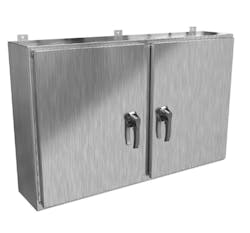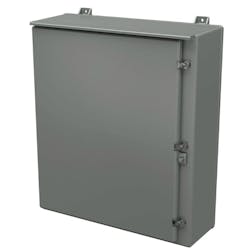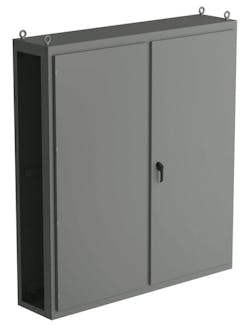In a world where automation and controls technology get increasingly more complex, you can count on the enclosure category to remain relatively simple and straightforward. That’s not to say there aren’t new enclosure-related developments and innovations. The product segment continues to progress with modular designs, new materials and safety capabilities that are gradually transforming enclosures to meet the needs of modern automation applications.
Jody Kinney (JK), product manager for enclosures at AutomationDirect, recently spoke with Automation World (AW) about how enclosure development is evolving. He also provided his take on what control engineers need to consider as they specify enclosure systems for new distributed and more intelligent automation applications.
AW: Have the design and functionality of control enclosures evolved over the years? If so, what would you cite as the most important developments?
JK: Because enclosures aren’t a high-tech item, they are not evolving at the same pace as other automation technologies. They are still essentially just boxes. Yet as the controls world has evolved, enclosures need to evolve as well. Many are now housing HMIs, while others have moved to the shop floor rather than being stuck in a corner like they have been.
There are also now more ways to mount enclosures and far more modularity. Modular enclosure designs allow for expansion, which is important in today’s data-dominated controls world where you frequently need to add capacity. With a modular system, you can remove side panels and bolt on another enclosure body, making it one big enclosure — that’s one of the biggest changes I’ve seen.
Modularity and more mounting options are important because of the way we interface with controls today. Historically, with fewer electronic controls, operators went to a wall and hit a switch or button to start up a machine. Now you have more control at the machine level where operators make fine adjustments using HMIs. Enclosures mounted on a pedestal or swing arm or in a larger, desk-style model create an environment that is more accessible and in tune with how people work.
AW: How do different materials (e.g., steel, aluminum, polycarbonate) affect the performance and suitability of enclosures for various applications?
JK: When designing an enclosure, pick the best material for your operating environment, but also the most cost effective. If there isn’t a requirement for any exotic materials, start with carbon steel, aluminum, plastic or stainless steel — those choices are the most cost effective.
Other guidelines depend on the environment. Understand if there’s a need to have the enclosure located outdoors, be submerged, or have potential exposure to corrosive substances like cleaning agents.
Most enclosures still default to carbon steel, especially when located indoors and without the need for wash down. When you get into smaller enclosures, fiber glass or polycarbonate can be used because they’re more cost effective. When you move into a scenario where something requires wash down, carbon steel isn’t a good option due to the potential for corrosion. Sheet aluminum enclosures are a niche application, but not right for specific types of chemical exposure that might affect them as the material is easy to bend and damage. Many factors have to be taken into account when choosing enclosure materials — there’s not a single rule of thumb.
AW: How do environmental factors influence the selection of industrial enclosures?
JK: Environment is everything because an enclosure’s role is to isolate internal components from factors such as dust, humidity and water. There are rating systems that specifically categorize enclosure environments. In the United States, we use the NEMA system. Know your environment and understand how it relates to NEMA ratings. From there, it’s simply matching what the manufacturer says the product is rated for and then testing it with your environment and needs.
AW: What safety features should industrial enclosures have to protect both the equipment and personnel?
JK: NEMA environmental ratings also take safety into account. Depending on where an enclosure is located, you need to consider what kind of security is necessary to keep people out. An enclosure located in a field or open area will dictate some kind of security to prevent human access. This is usually something simple — a quick latch or lock and key is sufficient. If it’s located indoors with building security monitoring employee access, a simple latch may be best. It’s the same decision process you might take if you had a shed to store a lawnmower — how secure the door needs to be depends on the neighborhood and how valuable the equipment is.
AW: What features are considered best to manage heat within enclosures?
JK: Heat management is not just an operational concern, it’s also a safety concern. It’s going to depend on your environment — how much heat must be managed or the ambient temperature around the enclosure. If located in an area with high ambient temperature, you might need a more active system. If an enclosure is built specifically to withstand water, you can’t depend on outside air to cool what’s inside, so the addition of fans might be a consideration. More sophisticated options include thermoelectric coolers or compressed air systems, which are more common in large plants. The options depend on how much heat you need to remove, what utilities are available, the average ambient temperature and what temperature you have to maintain in the enclosure. Cost is also an issue.
AW: What changes do you see coming to enclosures to meet the needs of industrial operations today amid industry’s digital transformation?
JK: As we become more data driven, we’ll see more equipment distributed at the edge, with smaller enclosures designed to accommodate smaller and more distributed equipment. Enclosures will also increasingly be set up for HMI applications. With industry’s digital transformation, it’s about the balance of enclosure types more so than any particular advances in the technology.
Leaders relevant to this article:



